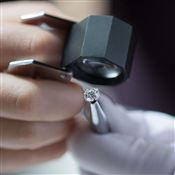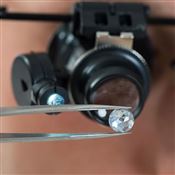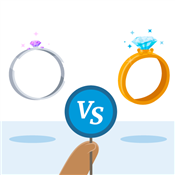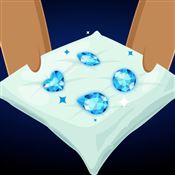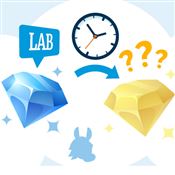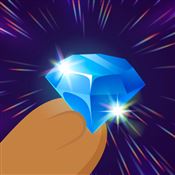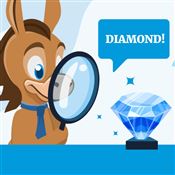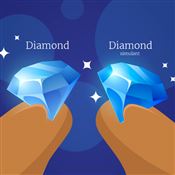Ideal Diamond Depth and Table
What is the ideal depth and table for a diamond? Here's how to calculate a diamond's maximum sparkle before you buy.
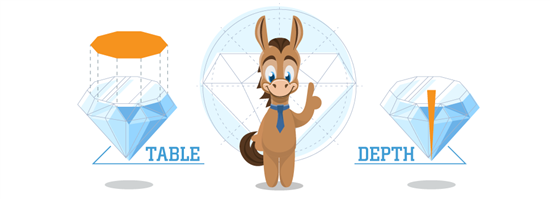 |
| © CreditDonkey |
You've heard of the 4 Cs. But there are other factors that influence a diamond's appearance. Diamond table, depth, and length/width ratio are important in how the diamond reflects and refracts light. This is also called light performance.
But how do you measure these factors? And are some more important than others?
Find out what to look for and hack the diamond buying game.
What Is the Ideal Diamond Proportion?
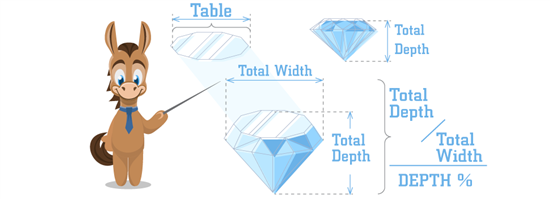 |
| © CreditDonkey |
Diamond proportion is the combination of:
- Diamond length/width ratio
- Diamond table percentage
- Diamond depth
The ideal diamond proportion depends on the diamond shape you choose. Even then, there is no definitive ideal proportion for every shape. But when a diamond proportion is perfectly balanced, it can take in maximum light. And reflect it back beautifully.
Below learn about the diamond table, depth, and length/width ratio. Plus how to use them to find your perfect diamond.
Diamond Length & Width Ratio
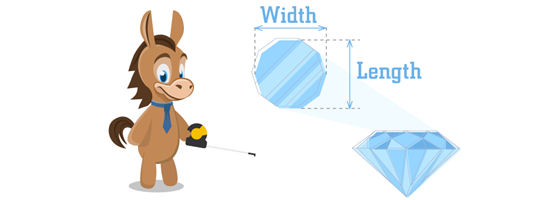 |
| © CreditDonkey |
The length/width ratio is pretty much what it sounds like. It's the length of the diamond divided by the width of the diamond.
The ideal length/width ratio will vary by diamond shape. Round diamonds should have a length and width that are almost exactly the same. Princess and asscher diamonds will also look best with a near equal length and width to emphasize their symmetry.
With all other shapes, it is up to personal preference. For instance:
- Some prefer a wider outline with less length.
- Others prefer a more dramatic taper and a longer appearance.
- Some who want a cushion shape diamond will prefer a more "square" appearance.
- Others favor the elongated version.
When looking at a diamond grading report, find the measurements, pull up your calculator app, and follow these steps:
- Look at the first two numbers of the measurements (length and width).
- Enter the larger of the two numbers into your calculator.
- Hit the divide sign, then enter the smaller of the two numbers.
- Press the equal sign. This is your diamond's L/W ratio.
Best Diamond L/W Ratio by Shape
If a diamond's L/W ratio is between 1.00 and 1.05, it will look symmetrically round or square.
If your number is 1.06 or higher, then you have a diamond that is more elongated in appearance. Here's a handy cheat sheet of preferred ratios by shape:
- Round: 1.0
- Princess: 1.00-1.05
- Cushion: Depends on preference
- Radiant: Depends on preference
- Emerald: 1.50-1.75
- Asscher: 1.00-1.05
- Oval: 1.30-1.70
- Pear: 1.50-1.75
- Marquise: 1.80-2.10
- Heart: 1.0
What Is the Table Size in a Diamond?
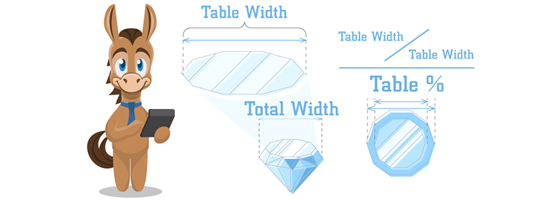 |
| © CreditDonkey |
The "table" is the largest facet on top of the diamond. Most of the light entering a diamond goes through the table. So how does it affect the diamond's overall shine?
The size of the table compared to the overall size of the diamond can determine if a diamond has enough light to sparkle. This is called table percentage.
If the table percentage is too small, the light will not be reflected back as brightly. This can result in a less brilliant appearance. But you may not want a diamond with too large a table, either.
Table width divided by total diamond width equals table percentage.
Best Diamond Table Percentage by Shape
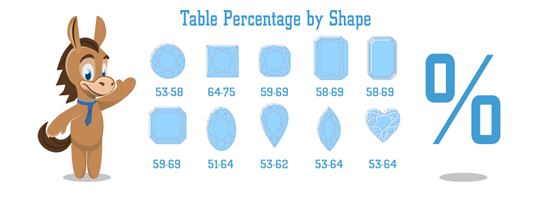 |
| © CreditDonkey |
When calculating your diamond's table percentage, utilize this cheat sheet to determine if your diamond will have maximum sparkle:
- Round: 53%-58%
- Princess: 64%-75%
- Cushion: 59%-69%
- Radiant: 58%-69%
- Emerald: 58%-69%
- Asscher: 59%-69%
- Oval: 51%-64%
- Pear: 53%-62%
- Marquise: 53%-64%
- Heart: 53%-64%
What Is Diamond Depth and Why Is It Important?
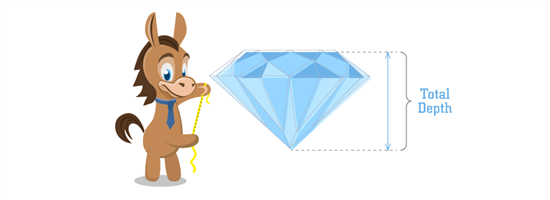 |
| © CreditDonkey |
Diamond depth refers to the height of the diamond. It's really that simple—how tall the diamond is from culet to table.
Simply put, the height of the diamond determines the size and shape of the facets on the bottom of the diamond. This has a direct impact on the way the light moves within the diamond. If the diamond is too tall or too short, it will appear less sparkly.
The culet is the sharp point at the bottom of the diamond. This point is where all facets of the pavilion, or the main base of the diamond, meet.
Best Diamond Depth by Shape
Diamond depth can be measured simply by calculating the distance from the top surface of the diamond to the bottom point. Here are some of the best diamond depth ranges to keep in mind when looking at certificates:
- Round: 58%-63%
- Princess: 64%-75%
- Cushion: 59%-69%
- Radiant: 58%-69%
- Emerald: 58%-69%
- Asscher: 59%-69%
- Oval: 58%-66%
- Pear: 56%-70%
- Marquise: 58%-66%
- Heart: 58%-66%
How Do I Choose the Ideal Diamond?
Simple math will do a lot of your work for you. If you look at the 4 Cs and factor in the information above, you're going to narrow your options to only the best diamonds.
As a recap, here's what you need to remember about the 4 Cs.
Carat
Many people assume carat to be the most important of the 4Cs. It has a huge influence on the price of a diamond and it's the most easily noticeable feature. Basically, this is how big the diamond appears.
But a huge 3-carat diamond isn't necessarily the most brilliant and beautiful. That's where cut, clarity, and color are especially important.
Finding the ideal diamond carat will come down to budget and preference. When you've settled on the size, you can start narrowing your choices by considering the other Cs.
Cut
Often overlooked, cut is the most important C when it comes to how brilliant the diamond appears. Prioritizing the cut is the easiest way to make sure your diamond is as radiant as possible.
Keep in mind that cut refers to the proportion, symmetry, and polish of a diamond, not its shape. Round, emerald, and cushion are different shapes, not cuts.
Try to find a diamond with an "Excellent" cut grade to get the most bang for your buck. Diamonds with a high-quality cut often appear larger than those of a higher-carat weight.
Clarity
Clarity refers to the flaws inside and on the surface of a diamond. Like carat, it is often thought to be more important than it really is.
The grading scale for clarity may seem complex. But there's only one thing you need to remember to find a flawless looking diamond: It needs to be eye-clean.
Eye-clean means that the diamond has no flaws visible to the naked eye. Clarity is usually graded under 10x, but no one will be able to examine your diamond with a microscope in real life.
Color
Finally, color refers to how colorless a diamond appears on a scale from D (colorless) to Z (yellow, brown tint). While a true colorless "D" diamond may seem desirable, you can get diamonds in the G-J range for a fraction of the price.
Diamonds graded G-J scale may have a slight yellow tint. But it will only be detectable to a gemologist with professional gear.
Similar to clarity and carat, you can save a fair amount of money by opting for lesser-grade diamonds. In reality, these diamonds will look indistinguishable to any layman.
Bottom Line
While these factors might seem overwhelming at first, taking a little time for research will equip you to find your perfect diamond. Consider table percentage, length/width ratio, and depth in combination with the 4 Cs and you will be in a good position to get the most value for your buck.
Write to Hillary C at feedback@creditdonkey.com. Follow us on Twitter and Facebook for our latest posts.
|
|
|
